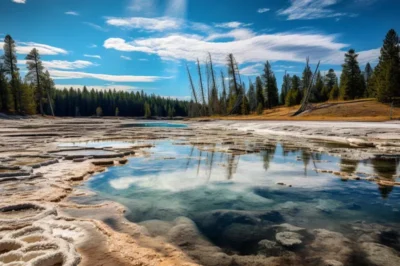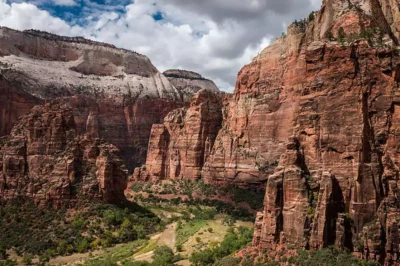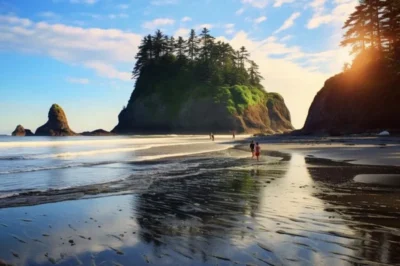Grand Prismatic Spring in Yellowstone National Park: The Largest Hot Spring in USA
Embarking on a journey to Yellowstone National Park, nestled in the rugged heart of Wyoming, is like stepping into a realm where nature unveils its most spectacular treasures. Among these, the Grand Prismatic Spring stands as a testament to the park’s majestic beauty and geothermal prowess.
- Geological History
- What to See at Midway Geyser Basin?
- Excelsior Geyser
- Grand Prismatic Spring
- Why is the Grand Prismatic Spring so colorful?
- What makes the Grand Prismatic Spring so special?
- How can I get the best view of Grand Prismatic Spring?
As you plan your visit, do’nt forget to stand atop the overlook, eyes sweeping across the largest hot spring in the United States, its vibrant colors a dazzling mirror of the sky.
Geological History
Into a world where the ground itself bubbles and steams, a vibrant tapestry of colors unfolding beneath your feet. This is the reality at Yellowstone National Park, Wyoming’s crown jewel. Here, a natural wonder, a spring of mesmerizing beauty, beckons with its deep blue waters and kaleidoscopic surroundings. It’s like gazing into a living rainbow, an artist’s palette of nature’s finest hues.
This spring isn’t just a feast for the eyes; it’s a chapter from Earth’s deep history. About 2.1 million years ago, our planet was a stage for colossal geological dramas. The Yellowstone Caldera emerged from a massive volcanic eruption, altering the landscape forever.
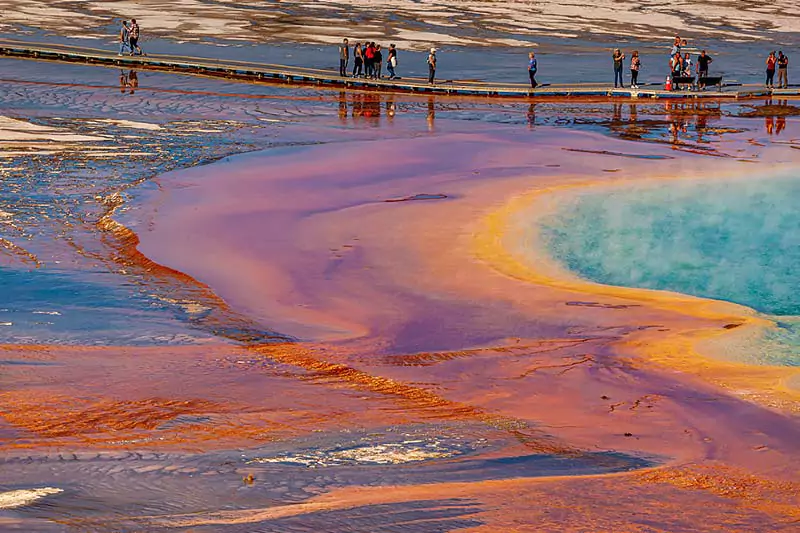
Fast forward to today, and this area, particularly the Midway Geyser Basin, is a testament to these ancient forces. It’s like stepping back in time or being part of an expedition into Earth’s fiery heart.
It’s a story that begins deep within the Earth. Water from rain and snow melting, seeping deep into the ground, only to be superheated by the Earth’s molten core. This journey isn’t short; it’s a winding path through a maze of fissures and cracks, a relentless pursuit towards the surface.
As this water travels, it’s like a sculptor, chiseling away at the rocks, picking up minerals, especially silica. Emerging triumphantly at the surface, the water brings these minerals with it, depositing them around the spring’s edges.
These deposits, over time, have crafted the spring’s iconic sinter terraces. The coloration you see – those vibrant reds, oranges, yellows, and greens – is the handiwork of microscopic organisms thriving in this steamy, mineral-rich environment. It’s a natural laboratory, showcasing how life can adapt and flourish in the most extreme conditions.
In Yellowstone, every step is a journey through millions of years of Earth’s history. From the deep blue waters of the springs to the explosive eruptions of geysers like Old Faithful, it’s a place where the past is always present, where every steam vent and mud pot whispers secrets of our planet’s fiery origins.
It’s not just a park; it’s a living, breathing chronicle of our Earth’s geological past, a place where every visitor becomes an explorer, uncovering the mysteries hidden beneath our feet.
What to See at Midway Geyser Basin?
The Midway Geyser Basin is home to several geothermal features, including geysers and fumaroles.
Other notable geothermal features include Excelsior Geyser Crater (the largest active geyser crater in the world), Opal Pool, Turquoise Pool.
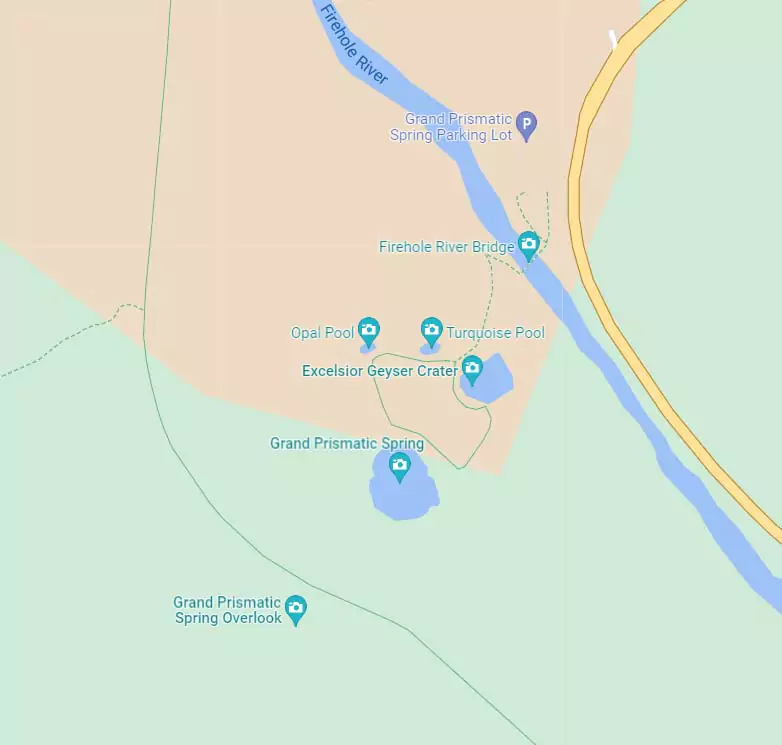
Excelsior Geyser
The Excelsior Geyser is an impressive sight to behold. This is the first geyser you come across on your trip here as you make your way along the wooden platforms. Excelsior Geyser is one of two large geysers in Yellowstone National Park.
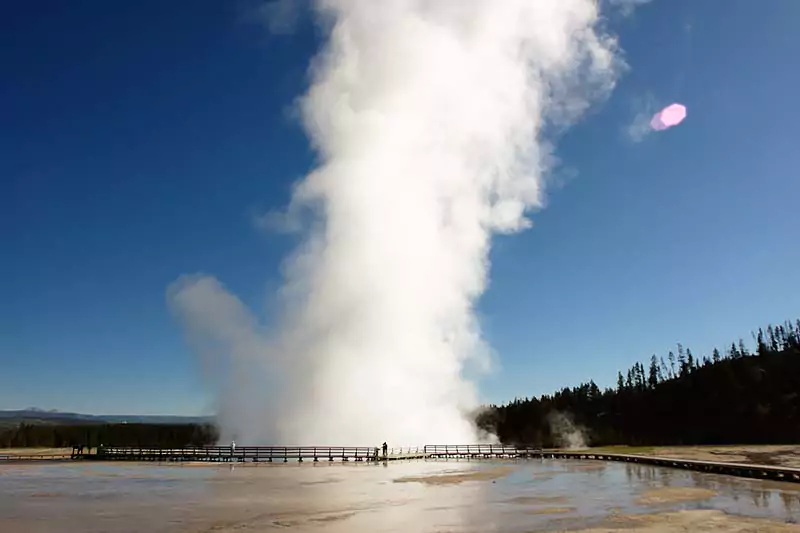
Once one of the world’s largest geysers, it has now transitioned into a hot spring, discharging more than 4,000 gallons (15,142 liters) of boiling water per minute into the Firehole River.
The pool measures approximately 200 feet by 300 feet (61 meters by 91 meters) and reaches depths of over 80 feet (24 meters). The striking blue color of the water and the steam rising from its surface create a captivating scene that visitors should not miss.
Grand Prismatic Spring
The spring gets its name from the great amount of heat that causes water to evaporate and form a prism. The spring is about 360 feet across and is surrounded by a boardwalk so that visitors can get a close up view.
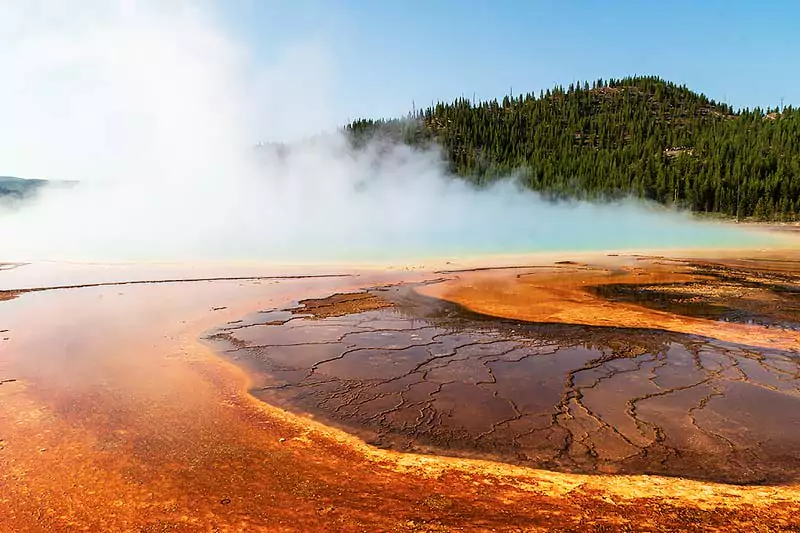
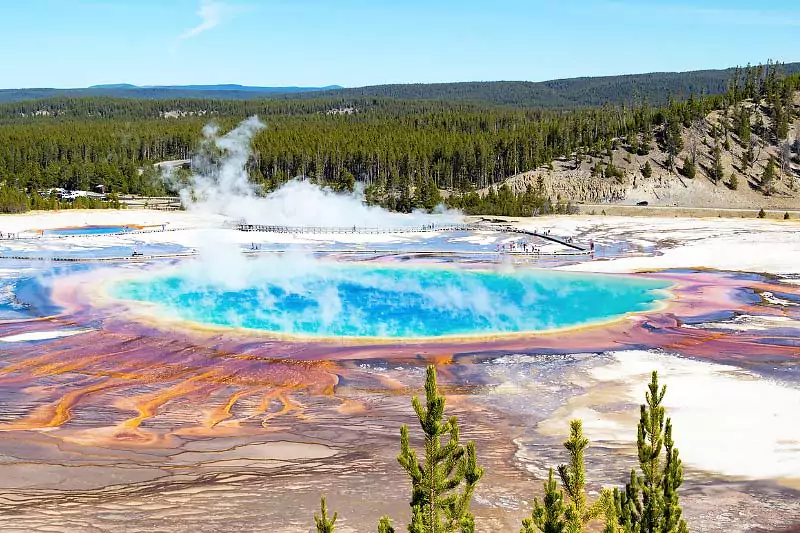
The intense heat of the spring creates an amazing effect on the surrounding area. The water evaporates so quickly that it forms a cloud of steam that can be seen for miles.
The bright colors are created by bacteria that thrive in the hot water. The different colors indicate different temperatures, with the blue being the coolest and the yellow being the hottest.
Why is the Grand Prismatic Spring so colorful?
The Grand Prismatic Spring, nestled in Yellowstone National Park, is not just the third largest spring in the world; it’s a canvas where nature paints its most vivid rainbow.
This natural wonder, stretching about 160 feet in diameter, owes its breathtaking palette primarily to a cast of microscopic artists: thermophiles, or heat-loving microorganisms.
Microorganisms: These tiny but mighty creatures, invisible to the naked eye, are the true alchemists behind the spring’s coloration. Different species of thermophiles, each with their unique pigments, carpet the area around the Grand Prismatic Spring.
For instance, cyanobacteria, equipped with chlorophyll and carotenoid pigments, create enchanting shades of green and blue, reminiscent of the hues found in a tranquil blue pool. In contrast, other thermophiles, thriving in slightly cooler waters, produce a spectrum of orange, yellow, and red hues, painting the edges of the spring in warm, fiery tones.
Water Temperature: But the story of the Grand Prismatic Spring’s colors is not just about the microbes. It’s also a tale of water temperature and mineral richness.
The spring’s center, known for its extremely hot water, can reach temperatures of around 189°F (87°C). Here, the water’s deep, vibrant blue is a result of white light scattering, allowing only blue wavelengths to reach our eyes.
As the heated water cools as it spreads from the center, it creates a hospitable environment for diverse thermophiles, adding to the spring’s kaleidoscopic allure.
Mineral Content: Furthermore, the water is teeming with minerals, a treasure trove dissolved from the surrounding rocks. Silica, iron, manganese – each plays its part in enhancing the spring’s vivid rainbow. Iron oxides, for instance, lend their reddish-orange tint, contributing to the warm spectrum visible around the spring’s periphery.
What makes the Grand Prismatic Spring so special?
The Grand Prismatic Spring in Yellowstone National Park is renowned for its breathtaking beauty and immense size, holding the title of the largest hot spring in the U.S. and the third largest in the world.
This natural wonder captivates visitors with its vivid rainbow colors, created by heat-loving bacteria thriving in its thermal waters. These pigmented bacteria form intricate patterns, adding to the spring’s enchanting visual appeal. The Grand Prismatic Spring’s significance is further highlighted by its historical context; it was first recorded by early European explorers during the Hayden Expedition of 1839.
Its prime location in Yellowstone’s thermal basin, near features like geysers and thermal pools, and its proximity to the Firehole River, make it a central attraction in the park. The spring’s allure draws crowds, often resulting in tour buses parking along the nearby area, where visitors can marvel at this geological treasure.
How can I get the best view of Grand Prismatic Spring?
For an unparalleled view of Grand Prismatic Spring, one of the most iconic hot springs in the United States, embarking on a hike to its overlook is a must.
This journey begins at the Fairy Falls Trail parking area, a spot conveniently located just about a mile south of the main parking area. The trail itself is a manageable 0.8-mile (1.3 km) trek one-way, weaving through the stunning landscapes of Yellowstone.
As you set off, you’ll be crossing the Firehole River, a scenic and integral part of the park’s geothermal ecosystem. The river’s name itself hints at the thermal features in Yellowstone, and crossing it feels like stepping into a world where nature’s heat bubbles just beneath the surface.
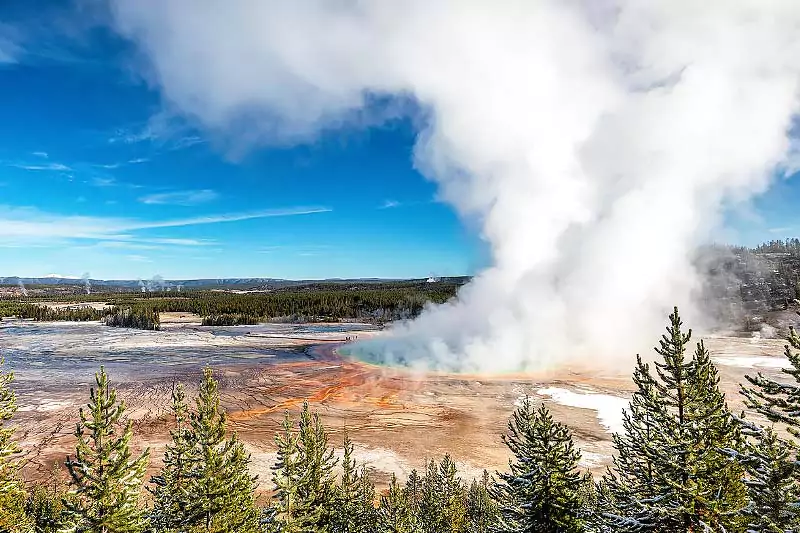
The trail to the Grand Prismatic Spring Overlook isn’t just a walk; it’s a breathing geological wonder. The trail is easy, and as you walk, you’ll be treated to diverse views of the park’s landscape.
Reaching the overlook, the view of Grand Prismatic Spring is breathtaking. From this vantage point, you can appreciate the spring’s immense size and the vibrant spectrum of colors – from deep blues to bright oranges and yellows – created by the unique types of bacteria that thrive in the hot, mineral-rich waters.
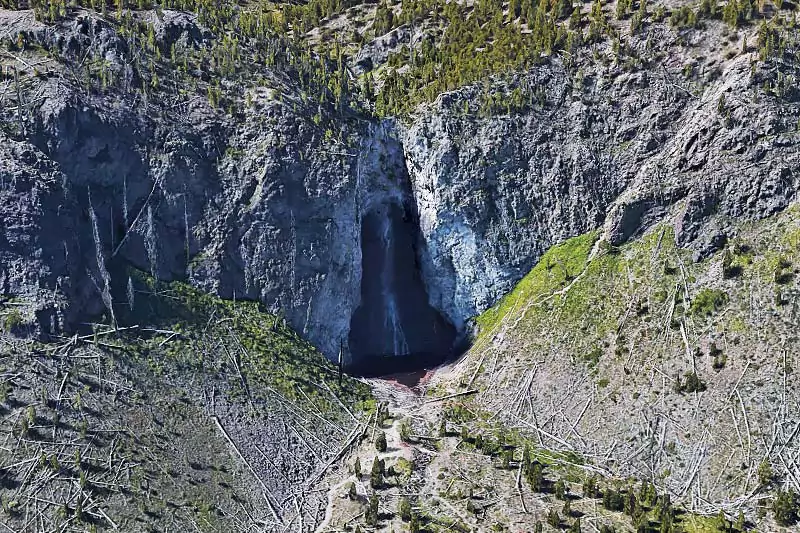
After enjoying the grandeur of the spring, if you’re up for a bit more exploration, continue on to Fairy Falls. Though not as grand as some other waterfalls, it offers a peaceful spot to reflect on the natural wonders you’ve witnessed. And if you’ve packed a lunch, the nearby picnic area offers a perfect spot to relax and soak in the beauty of Yellowstone.
Opal Pool
Opal Pool in Yellowstone is a small yet captivating natural feature. Its most striking aspect is its brilliant blue color, which stands out amidst a palette of green, yellow, and orange hues, created by the microbial mats along its edges.
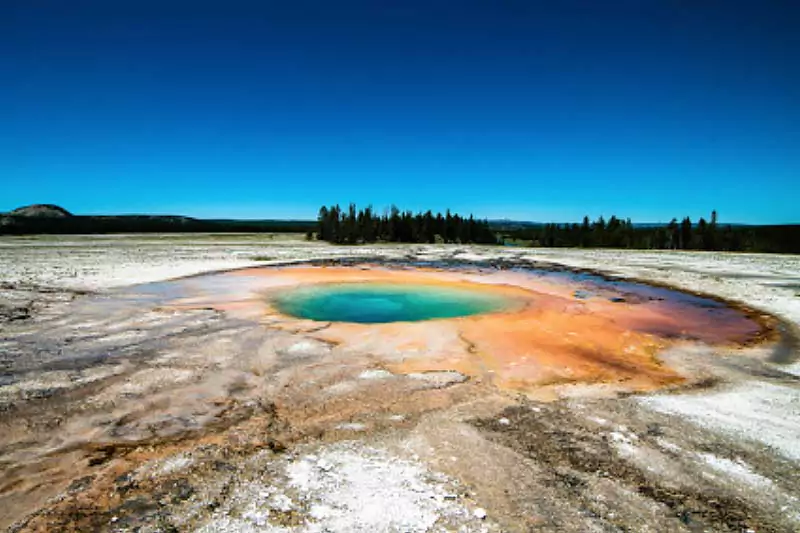
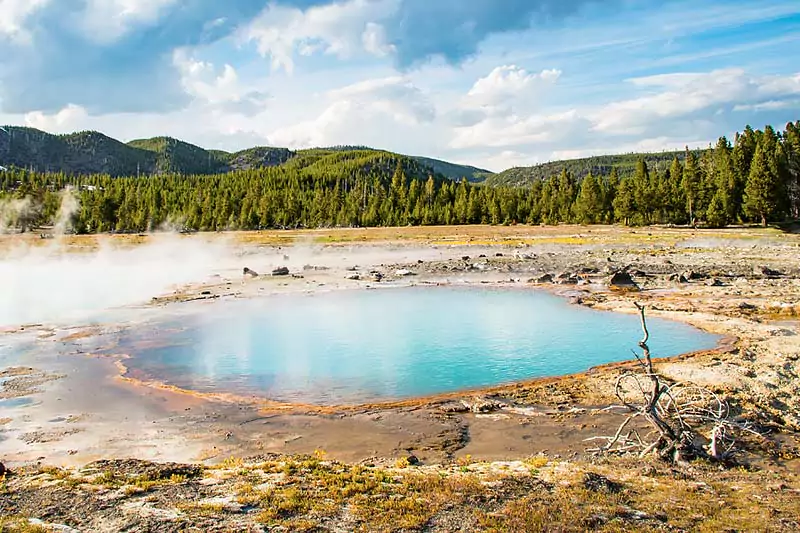
Due to its smaller size, Opal Pool is particularly sensitive to seasonal changes. In winter, it’s often the first to ice over and the last to thaw, lacking substantial steam to hasten the process.
Although typically serene, Opal Pool can surprise visitors by sporadically erupting as a geyser, adding to its allure. Caution is advised, as with all geothermal features, to keep a safe distance.
Turquoise Pool
True to its name, Turquoise Pool is a stunning feature of Yellowstone, renowned for its vivid turquoise waters. This pool is encircled by elaborate sinter formations and bright microbial mats, creating a striking visual contrast.
Its shallower and cooler waters compared to other springs in the area support a diverse array of thermophilic microorganisms.
Tips for visiting Midway Geyser Basin
- Respect the Trails: Always stick to the designated paths and boardwalks. Venturing off-trail can be dangerous, as the ground around the springs is unstable and can lead to accidents.
- Avoid Touching the Water: The water in the geysers and springs is extremely hot. Resist the temptation to touch or dip into these captivating but perilous waters.
- Be Mindful of Steam and Heat: The area can be steamy, obscuring vision and posing burn risks. The heat can also cause dehydration, so it’s important to stay hydrated and take breaks.
- Observe Wildlife from a Distance: The Midway Geyser Basin is home to various wildlife, including elk and bison. Appreciate these animals from a safe distance to avoid disturbing them.
- Capture the Moment: The basin’s scenery is breathtaking, so bring a camera. Remember, though, that drones are typically not allowed in national parks.
- Appreciate the Geological Marvel: Take time to observe where the water emerges and how it bubbles, showcasing the dynamic geothermal activity of the basin.
- Plan for Parking and Crowds: The basin may be small, but it’s a popular spot. Arrive early or later in the day to avoid crowds and find parking more easily.
FAQs
How Hot is the Grand Prismatic Spring?
The spring is incredibly hot, with temperatures in the center of the pool reaching up to 189°F (87°C).
As the water flows outward from the center, the temperature gradually decreases, creating a range of temperatures that support different types of heat-loving microorganisms. This variation in temperature is one of the factors contributing to the vibrant colors seen around the edges of the spring.
Can You Swim in the Grand Prismatic Spring?
Swimming is strictly prohibited due to the extreme temperatures and the fragile ecosystem it supports. The National Park Service enforces regulations to protect the spring and its unique features, and violating these rules can result in fines, penalties, or even criminal charges.
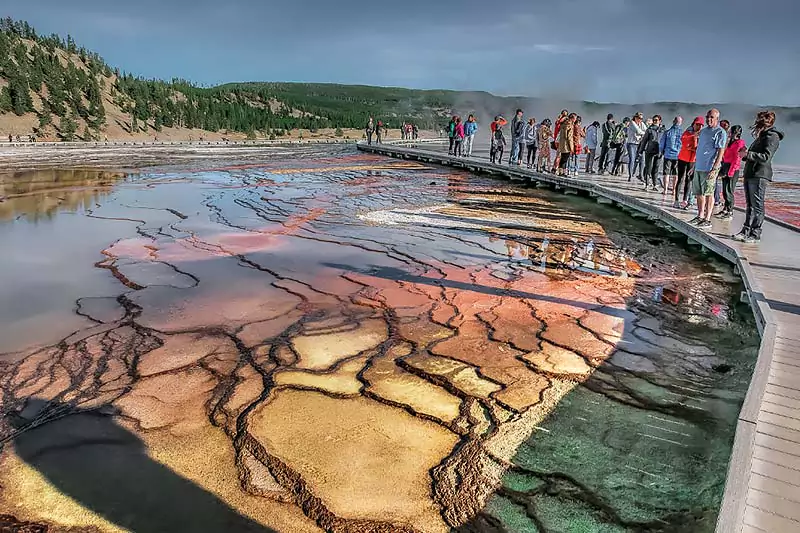
What Happens if You Touch or Swim in the Great Prismatic Spring?
Touching or swimming is not only illegal but also extremely dangerous. The scalding water can cause severe burns and even be life-threatening.
Furthermore, human contact with the spring can damage the delicate microbial mats and disrupt the ecosystem, which in turn impacts the spring’s appearance and health. Never step off the boardwalks.
Does the Grand Prismatic Spring Smell?
Yes, it smells. It does have a distinct smell, often described as a “rotten egg” odor. This smell is due to the presence of hydrogen sulfide, a gas produced by some of the thermophilic microorganisms living in the hot spring.
While the smell may be strong and unpleasant at times, it is a natural byproduct of the unique ecosystem found within the spring.
Best Times to Visit for Optimal Viewing
It is a year-round attraction, but the best time to visit for optimal viewing depends on the weather and the time of day. The spring’s vibrant colors are most visible on sunny days when sunlight can penetrate the steam rising from the hot water.
When to visit the Grand Prismatic Spring? Therefore, visiting during the summer months from June to September, when the weather is generally clear and warm, will maximize your chances of witnessing the spring’s full spectrum of colors.
Additionally, consider visiting during the morning or late afternoon when the sun is lower in the sky. This will reduce glare on the water’s surface and make the colors more pronounced.
Finally, to avoid crowds and enjoy a more serene experience, consider visiting during the shoulder seasons of May or October, when the park is less crowded but still offers favorable weather conditions.
How to Get to Grand Prismatic Spring?
Reaching here in Yellowstone National Park involves a combination of transportation methods and some preparation, but with the right information, the journey becomes a smooth and enjoyable experience.
The first step to visiting this place is reaching Yellowstone National Park itself. The park is accessible by car, with five entrance points: North, Northeast, East, South, and West.
- Personal Vehicle: The most popular option is to use your own vehicle or rental car. This gives you the most flexibility and freedom to explore the park at your own pace.
- Guided Tours: Several companies offer guided bus tours that include stops at major attractions, including the Great Prismatic Spring. This option allows you to sit back, relax and learn more about the park from knowledgeable guides.
- Bicycling: Yellowstone has designated bike paths and some visitors prefer to explore the park by bike. However, keep in mind that bicycles are not allowed on boardwalks or trails, so you will need to lock your bike to a designated rack near the spring and continue on foot.
- By car: It can be found within Midway Geyser Basin – a location that visitors may reach by utilizing Grand Loop Road – Yellowstone National Park’s primary roadway.
Those coming from entrance near West should take note to traverse around 20 miles (32km) of this path before finally reaching their destination at Midway Geyser Basin’s car parking area. Meanwhile, guests who begin their journey from South entrance must brave a much longer distance of approximately 45 miles (72km).
Parking and Additional Information
Parking can be limited, especially during peak season. Arriving early in the morning or later in the afternoon can increase your chances of finding a parking spot. If the main parking area is full, additional parking can be found along the Grand Loop Road, but be prepared to walk a bit further.
Remember that the boardwalks and trails around the place can be slippery due to the moist environment. Wear sturdy footwear, stay on designated pathways, and follow all posted safety guidelines to ensure a safe and enjoyable visit.
Video
Conclusion
The Grand Prismatic Spring’s mesmerizing display of color and geologic forces never fails to captivate its visitors. Through gaining an understanding of the scientific explanations and historical context surrounding this natural phenomenon, a deeper appreciation for its magnificence can be attained.
To witness the full spectrum of colors that this hot spring exhibits, timing one’s visit during optimal viewing periods is highly recommended.
